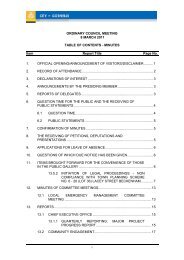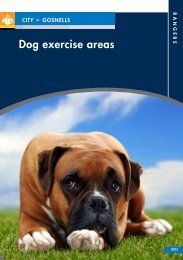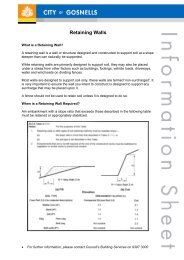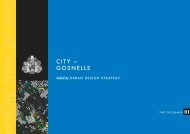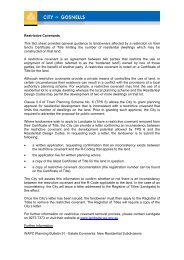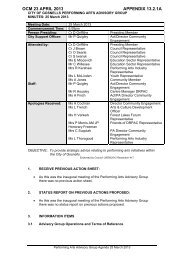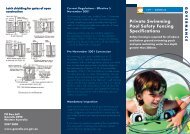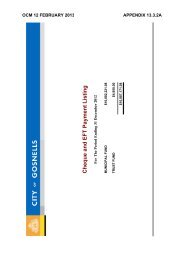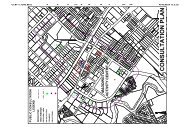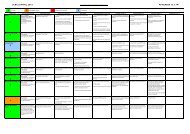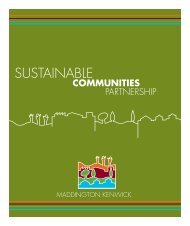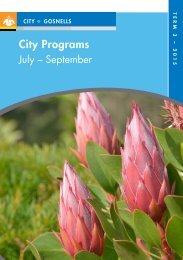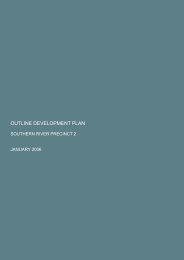<strong>Summary</strong>ii<strong>Summary</strong>The <strong>City</strong> <strong>of</strong> <strong>Gosnells</strong> is currently involved in investigating, and planning for, future industrial developmentwithin a 585 ha area <strong>of</strong> rural land (that is known as the Maddington Kenwick Strategic Employment Area orMKSEA), in the north-east <strong>of</strong> its jurisdiction. The area proposed for development (<strong>City</strong> <strong>of</strong> <strong>Gosnells</strong>, 2007a)is located on the eastern side <strong>of</strong> the Swan Coastal Plain (SCP) and has been shown to include values <strong>of</strong>national conservation significance listed under the Federal Environmental Protection and BiodiversityConservation (EPBC) Act (Cardno BSD, 2005). Within the boundary <strong>of</strong> the MKSEA, but not proposed fordevelopment, there are two Bush Forever sites (BFS 387, the Greater Brixton Street Wetlands, and BFS 53,the Clifford Street Bushland). The Bush Forever sites include multiple conservation values that are listed asnationally significant (Government <strong>of</strong> Western Australia, 2000). BFS 387, the most species-rich BushForever site on the SCP and one <strong>of</strong> the most important conservation reserves on the SCP, is locateddownslope from much <strong>of</strong> the MKSEA and is influenced by groundwater and surface water drainage from theMKSEA. BFS 387 is currently subject to high levels <strong>of</strong> stress from threats within its boundaries and from thesurrounding MKSEA. These threats are not addressed currently by any coordinated management efforts andwill require considerable effort to resolve. The local Bush Forever sites are closely coupled with theadjoining MKSEA rural areas via ecological and biological processes and the proposed development is likelyto impact, at least indirectly, on their important conservation values.Environmental and engineering studies <strong>of</strong> the MKSEA (Cardno BSD, 2005; GHD, 2005) found that, apartfrom some areas <strong>of</strong> dunes in the south east, most <strong>of</strong> the area proposed for development is an extensive, gentlysloping, seasonally-waterlogged plain (palusplain) that is part <strong>of</strong> the Bickley Brook and Yule Brookcatchments. These preliminary reports also indicated that the legislation and policies <strong>of</strong> Federal and Stateenvironmental regulatory agencies with regard to the high conservation values found in parts <strong>of</strong> the proposeddevelopment area would significantly constrain the extent <strong>of</strong> industrial development in the MKSEA. Thecurrent Level 2 flora, vegetation and wetlands survey <strong>of</strong> the MKSEA was commissioned by the <strong>City</strong> <strong>of</strong><strong>Gosnells</strong> in early September 2007 to provide more detailed guidance to the MKSEA planning process.Pending the outcomes <strong>of</strong> this study, and the results <strong>of</strong> other investigations (such as an Aboriginal heritagestudy), the <strong>City</strong> <strong>of</strong> <strong>Gosnells</strong> has issued two modified Concept Plans for the MKSEA (<strong>City</strong> <strong>of</strong> <strong>Gosnells</strong>,2007b, 2008).The current flora, vegetation and wetlands survey found numerous conservation values <strong>of</strong> national, state andregional significance within the MKSEA (Table A). Some <strong>of</strong> the values found in the current survey were notidentified in the MKSEA in previous studies (Government <strong>of</strong> Western Australia, 2000b; Cardno BSD, 2005;Trudgen and Keighery, 1995) and are not represented in the Greater Brixton Street Wetlands or the CliffordStreet Bushland (Government <strong>of</strong> Western Australia, 2000b). In accord with Western Australian StateGovernment and Local Government criteria regarding the conservation value <strong>of</strong> natural areas (Government<strong>of</strong> Western Australia, 2000; Lamond, 2009) all areas <strong>of</strong> remnant vegetation assessed as being in good orbetter condition within the MKSEA in this study were considered to be <strong>of</strong>, at least, regional conservationsignificance. These areas <strong>of</strong> eastern Swan Coastal Plain remnant native vegetation in the MKSEA areconsidered to be rare biodiversity resources that are poorly represented in the conservation estate and arethus eligible for protection.Most <strong>of</strong> the flora and vegetation <strong>of</strong> high conservation significance found in the MKSEA in the current surveyare highly dependent on surface waters and/or groundwater. However, the extensive wetland ecosystem <strong>of</strong>the alluvial fan system that encompasses most <strong>of</strong> the MKSEA and the two Bush Forever sites <strong>of</strong> the area hasbeen somewhat compromised by existing development. There is now reduced recharge <strong>of</strong> rainfall intogroundwater and increased surface run-<strong>of</strong>f due to the clearing <strong>of</strong> vegetation and the compaction <strong>of</strong> soils.There is also localised dewatering <strong>of</strong> wetlands by excavated drains that intersect superficial aquifers andexport groundwater, along with run-<strong>of</strong>f, to Yule Brook and Bickley Brook. Yule Brook and Bickley Brookhave been converted from high quality water sources (that previously sustained the rich biodiversity <strong>of</strong> theadjoining floodplains, including BFS 387, by annual flooding and sediment deposition) to water sinks thatconvey polluted, nutrient-enriched water out <strong>of</strong> the local wetlands and into the Swan-Canning River system.The complex hydrogeology <strong>of</strong> the MKSEA and the Bush Forever lands needs to be more fully understood sothat any proposed development does not reinforce the current problems (locally and downstream in the SwanTauss, C. and Weston, A.S. (2010). The flora, vegetation and wetlands <strong>of</strong> the Maddington-Kenwick Strategic Employment Area.A survey <strong>of</strong> the rural lands in the vicinity <strong>of</strong> the Greater Brixton Street Wetlands. Report to the <strong>City</strong> <strong>of</strong> <strong>Gosnells</strong>, W.A. Version 18.04.10
<strong>Summary</strong>iiiCanning River system) and exacerbate adverse environmental impacts. The importance <strong>of</strong> the restoration <strong>of</strong>the hydrological regime <strong>of</strong> the area is particularly highlighted by predictions <strong>of</strong> continuing rainfall decline inthe region and the threat that this poses to regional biodiversity.RecommendationsThis survey provided significant new information about the natural values <strong>of</strong> the MKSEA that should beconsidered in the planning process. However, there are major shortfalls in the current understanding <strong>of</strong> thebiological, ecological and physical processes (such as the hydrological maintenance <strong>of</strong> wetlands; thereproductive strategies, demography and genetics <strong>of</strong> threatened flora species; and the use <strong>of</strong> the area by faunaand their migration patterns) and in the definition <strong>of</strong> the basic habitat requirements <strong>of</strong> the Threatened Floraand the Threatened Ecological Communities <strong>of</strong> the area. There have been no threshold values defined for keyvariables (such as the ecological water requirements <strong>of</strong> Threatened Flora Species and Threatened EcologicalCommunities) that should form the basis <strong>of</strong> any assessment <strong>of</strong> the potential effects <strong>of</strong> various planningscenarios on the important conservation values <strong>of</strong> the area. Further study into these aspects would berequired to ensure that the proposed rezoning and development <strong>of</strong> the MKSEA will not contribute to thefurther degradation and loss <strong>of</strong> environmental values in the MKSEA, BFS 387 and BFS 53.The current survey identified and mapped areas <strong>of</strong> high conservation significance that should be excludedfrom development and proposed a number <strong>of</strong> general recommendations to assist in the prevention <strong>of</strong> some <strong>of</strong>the ongoing current and anticipated degradation and loss <strong>of</strong> conservation values in the MKSEA, BFS 387and BFS 53. These recommendations (Section 7.1) include the urgent need to implement recovery actions formost <strong>of</strong> the Threatened Flora Species populations in the MKSEA and the Bush Forever Sites; theenforcement <strong>of</strong> native vegetation clearing regulations and wetland conservation measures; and theidentification and control <strong>of</strong> existing land uses that are currently impacting on groundwater quality. Anumber <strong>of</strong> changes to the management categories <strong>of</strong> wetlands in the MKSEA are recommended. Appropriatebuffer zones around Conservation and Resource Enhancement Category Wetlands and Ecological LinkageCorridors between high conservation value areas within the MKSEA, BFS 387, BFS 53, the Darling Rangeand Canning River are also proposed and mapped.Three major recommendations are presented below that summarise the most important conclusions <strong>of</strong> thecurrent survey with regard to the proposed development in the MKSEA.Recommendation 1Given the significant conservation values within and adjacent to the proposed MKSEA and the potential forthese values to be adversely impacted by the proposal, the <strong>City</strong> <strong>of</strong> <strong>Gosnells</strong> is advised <strong>of</strong> its obligation torefer, for assessment, the proposal to re-zone and develop these rural lands to:• The Federal Department <strong>of</strong> Environment, Water, Heritage and the Arts (DEWHA) under the statutoryrequirements <strong>of</strong> the Federal Environmental Protection and Biodiversity Conservation Act, 1999; and• The Western Australian Environmental Protection Authority under the statutory requirements <strong>of</strong> theWestern Australian Environmental Protection Act, 1986.Recommendation 2The <strong>City</strong> <strong>of</strong> <strong>Gosnells</strong> is advised that further detailed studies are required to understand the hydrogeology <strong>of</strong>the highly water-dependent ecosystems <strong>of</strong> the MKSEA and the Greater Brixton Street Wetlands and toprovide the data required to remediate the hydrological regime <strong>of</strong> the area. The scope, methods and lowintensity <strong>of</strong> the current wetlands survey and the water monitoring programme recently commissioned by the<strong>City</strong> <strong>of</strong> <strong>Gosnells</strong> are considered insufficient to adequately map the major wetland boundaries, to characterisethe factors that maintain important conservation wetlands in the area and to define the environmental waterrequirements <strong>of</strong> the remnant native vegetation. Detailed mapping <strong>of</strong> the Muchea Limestone aquifers <strong>of</strong> thearea and an invertebrate study <strong>of</strong> the active Muchea Limestone mound spring in the MKSEA (and possiblyTauss, C. and Weston, A.S. (2010). The flora, vegetation and wetlands <strong>of</strong> the Maddington-Kenwick Strategic Employment Area.A survey <strong>of</strong> the rural lands in the vicinity <strong>of</strong> the Greater Brixton Street Wetlands. Report to the <strong>City</strong> <strong>of</strong> <strong>Gosnells</strong>, W.A. Version 18.04.10



